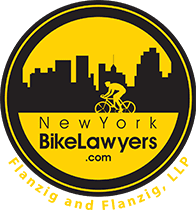BIKE CRASHES AND ACCIDENTS INVOLVING STREET DEFECTS, POTHOLES, AND OTHER ROADWAY CONDITIONS
February 13, 2015 / Wheels of Justice
The roads and highways of New York are well known for their potholes and other defects. A small pothole or road condition may be meaningless to a car but can pose a real danger to a cyclist. The time has come for municipalities and utility companies working on streets to realize that a road must be safe not only for passing motorist vehicles but also the bikes that regularly and lawfully share the road. The type of conditions that pose dangers to cyclists include:
- Pot Holes
- Road Hardware such as Manhole Covers and Utility Vaults
- Construction Plates
- Road Cuts, Trenches, and other Temporary Paving
- Grates and Sewers
- Construction Debris and Negligently Placed Equipment
- Negligently Placed Dumpsters or Other Demolition Equipment
- Hummocks
- Ponding
- Improperly marked or placed speed bumps or speed humps
If you are a cyclist who suffers a crash as a result of any of these street conditions, you may be able to bring a claim. Most of these claims involve the local municipality whose duty it was to maintain the road or who may have caused the condition.
Notice of Claim Requirements
Before you can bring a lawsuit against a town, city or public agency in New York, you must first file a Notice of Claim. Under New York Law, you must file the Notice of Claim within 90 days of the incident. If you fail to file a Notice of Claim within 90 days, then you very well may lose the right to file a lawsuit. In some circumstances, the notice of claim requirement can be extended upon good cause as found by a Court.
If you have been involved in a crash involving a road defect we suggest you contact a competent attorney familiar with this area of law as soon as possible so that a timely Notice of Claim can be filed. If you can, take photos of the condition. If you cannot, have someone do it for you. These conditions are often transient and can be repaired or corrected within hours of your crash.
Proving Notice of the Condition
In New York, one of the more difficult cases to prove is a cas
e involving a pothole in a city street. In almost all cases in New York, you must prove that the city or municipality had “prior written notice of the defect” before your collision occurred. However, if you can prove that the City or Municipality “affirmatively” created the condition or had worked in the area prior to the crash and created the conditions, you might be able to maintain a claim.
If you were involved in a crash or see a road defect, REPORT IT! Even if you were not hurt, by reporting it you help protect your fellow cyclists who may later face the same defect and not be so lucky. Although the most preferred method of reporting the condition is by letter, certified mail return receipt requested; there are other methods available. In NYC, if you see a dangerous street defect, take a picture or video and report it to the local municipality via the NYC 311 App or going online at nyc.gov.
Other municipalities utilize See, Click Fix. According to their website “SeeClickFix allows anyone to report and track non-emergency issues anywhere in the world via the internet. This empowers citizens, community groups, media organizations and governments to take care of and improve their neighborhoods.”
The duty to keep the roads safe for all who use them rests with the municipality. Cyclists who see a dangerous condition owe it to each other to report it so that no one faces an unnecessary injury that could have easily been avoided.
Who owns the Manhole Cover, Street Plate, or other Hardware?
Utility Companies normally have markings on street hardware. The markings are in the form of abbreviations, such as MGO or WSNY. A list of commonly used markings in New York City can be found here. There is no guarantee that these markings are accurate or that it demonstrates the true owner. Further investigation is always needed.
The law is different when it comes to road hardware such as manholes, vaults and plates that may be owned and maintained by private companies or utility providers such as Consolidated Edison (Con Ed) or Verizon. In NYC, these entities are required by the New York City Administrative Code to maintain the area 12″ inches around the structure, flush with the road surface. (11 RCNY2-14) This is what we call the 12″ Rule, and it creates a basis for liability for the entity that owns and maintains the street hardware.
Street opening plates (traffic plates) are required to be “pinned” in place so that they do not shift or move from vehicle traffic, and should ramped in order to keep them in secure positions, as well as a smooth transition as one traverses the plate. If a contractor utilized and plates during a street opening, the responsible to properly pin and ramp the plate, as well as to properly maintain the surrounding roadway, lies with the contractor.
A contractor working on a street is required to keep all areas used by the public in a safe condition and typically obligated to keep the work area free from debris, equipment, materials, projections or conditions that may cause a slipping, tripping or other hazards.
A crash involving a road condition requires prompt investigation and timely service of a notice of claim. If you have been involved in crash involving a street defect you should contact an attorney familiar with handling these types of claims as soon as possible so that the case can be promptly investigated and notice of claim filed with the responsible entity.
About “Wheels of Justice”
These are some of our guidelines on what to do if you are involved in a bike crash or collision. They are provided by Daniel Flanzig Esq. of NewYorkBikeLawyers.com (Flanzig and Flanzig, LLP) and Jim Reed, Esq. of Zifflaw.com. We are New York Attorneys focusing on the rights and protection of cyclists across New York. Nothing on this page should be construed as legal advice nor does the use of this page or column create an attorney/client relationship. The advice on this page offers a general overview of the laws in New York. Remember, every incident or claim is specific, and the guidelines may not be applicable to your particular case. As always, we suggest contacting an attorney with any legal claim or issue before taking action on your own behalf.


